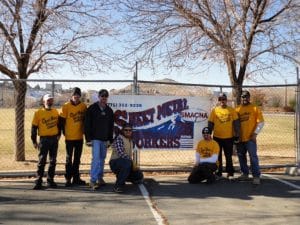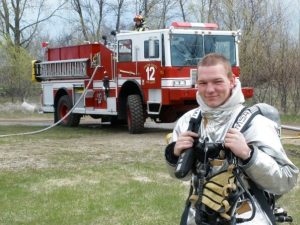 Change is hard and for many it is difficult to accept. Change is not an event with an exact start and stop point; it’s a process. Each step you make, even if it’s a relatively small step, is still a step in the right direction, driving you closer to where you want to go. Sometimes the road ahead looks hazy and your footing may be unsure, but it is ludicrous to turn back when seeking out a destination— no matter how distant your destination may seem at times.
Change is hard and for many it is difficult to accept. Change is not an event with an exact start and stop point; it’s a process. Each step you make, even if it’s a relatively small step, is still a step in the right direction, driving you closer to where you want to go. Sometimes the road ahead looks hazy and your footing may be unsure, but it is ludicrous to turn back when seeking out a destination— no matter how distant your destination may seem at times.
The changes we face now focus not just on the SMART Constitution which governs our combined organization, but also on the culture in which we operate. How this organization is run goes a long way in ensuring that it always serves the membership with integrity. Members cannot have confidence in an organization unless they are assured they have a voice in it. That is why, for those of you that know me, I try to adhere to as much transparency as possible, so that you as a member are kept both wellinformed and able to hold your leadership accountable.
SMART does not operate for the sake of its leaders. The leadership of this organization exists to represent all of us with integrity, honesty and to the best of our abilities.
It takes a lot of courage to move away from the security that comes with the way things had always been done before. But there is no real security in what no longer works to strengthen and advance this new union. The strength of SMART, and what will drive us to thrive in the future, comes from our ability to maintain the advances previous generations made and to build upon them. We deal with political, economic, and cultural challenges from all sides as our world changes every day. Sometimes we must adapt and change with it while staying true to the guiding principles of solidarity, strong representation and brotherhood that gave rise to our labor movement.
As you may already know, we recently completed our new Constitution, merging the former Sheet Metal Workers’ International Association and the United Transportation Union into SMART. While our merger has been complete for some time, this document unifies this great union and its members under a single Constitution.
In getting to this point, we examined and debated every constitutional section thoroughly before reaching agreement. At times, it required the help of an outside arbitrator to clarify a particular issue. While this slowed the process, it must be remembered the parties were tasked with combining 100 years of separate cultures and operations into a single Constitution that would govern our combined union while reflecting the practices and policies of both former organizations.
While the process may at times have been slow and laborious, we remain dedicated to working together to represent the best interests of members above all else.
An example of this is in the SMART General Executive Council (GEC) which is comprised of both sheet metal and transportation division General Vice Presidents. The GEC represents our diverse geographic, trade and work-related membership and acts as a check in many of the authorities assigned to the General President. Among these is the GEC’s Finance Committee which reviews the overall expenditures of the International Association including all personal expenditures of the General President and General Secretary-Treasurer. This sub-committee of the GEC also reviews the annual budget of the International including a separation of expenses by each department within the organization and makes recommendations to the full GEC who must approve the budget. This among many other oversight duties ensures accountability to the membership across all levels of the organization both now and in the future.
I urge all of you to view the SMART Constitution at www. smart-union.org/our-union/smartconstitution. Keep in mind that changes were made to the former UTU Constitution, now Article 21B of the SMART Constitution, where language within and the merger agreement dictated changes to comply with the SMWIA Constitution. In the near future we will also be posting a Frequently Asked Questions (FAQ) page to answer any questions about the new Constitution and upcoming SMART Transportation Division Convention in June and the SMART General Convention in August 2014.
It’s been a long and difficult process, and you deserve our gratitude for your patience. I look forward to moving our Union ahead united and stronger.
Fraternally,
Joseph J Nigro
General President
Author: paul
Matt Doehring, Business Manager of SMART Local 26 is a proud lifetime member of the community of Sparks, NV. Called the “Rail City,” Sparks is a medium-sized community with a proud railroad heritage. A vintage steam locomotive, cupola caboose, and Pullman executive car are displayed in the historic downtown, as well as a depot replica and a monument to the Chinese rail workers who toiled on the construction of the early rail lines.
Even with the day to day duties and responsibilities that come with being a Building Trades Business Manager, Local 26 Business Manager Matt Doehring coordinates efforts at the seasonal Keep Truckee Meadows Beautiful Christmas tree recycling station, along with other Local 26 sheet metal workers. Recently, the Sparks Tribune recognized Doehring and Local 26 for its volunteer efforts on behalf of the community.
Doehring told the Tribune, “(I do) whatever I can do to try and make things the best possible under any circumstances. As you start to get older, you start to think about giving back…It just feels right.”
Doehring hopes to strengthen SMART’s ties to the local community, boost member morale, and inspire lasting volunteer efforts. “Everyone who comes to drop off their tree is always in a great mood. It’s just an overall fun day,” he said. “It makes my heart smile at the end of the day to know that I’ve given back to the community.”
Local 26 members have coordinated and participated in a number of volunteer events in addition to the tree drop-off, like the Washoe County School District book drive and the KTMB E-Waste recycling days.
Local 19 Wins Election at Singer Equipment Company
After a long fight with Singer Equipment Company— from the stipulation hearing to the ground campaign—Local 19 sheet metal workers recently won an election on December 19. The owner fought the whole way, but the workers stood strong, with a unanimous decision in the end.
According to Local 19 Business Manager Gary Masino, “We are looking forward to garnering a fair agreement for these workers and feel the possibility of attaining one is strong in this case.”
Singer Equipment Company is currently the fourth largest foodservice equipment dealer in the United States. Singer also provides kitchen equipment on a nationwide basis to chain restaurants and contract feeders.
WASHINGTON – On the floor of the U.S. Senate, Sen. Heidi Heitkamp Feb. 10 shared the heroic story of Geoff Andersen, an engineer in training for Burlington Northern Santé Fe railroad, from Larimore, N.D., whose actions during the recent train derailment near Casselton, N.D., prevented the dangerous explosions from the crash from spreading farther.
(Andersen is a member of SMART Transportation Division Local 525 at Grand Forks, N.D.)
As a former civilian firefighter for the Grand Forks Air Force Base, Geoff was quick to think of a plan to unhook remaining oil cars and pull them safely away from the explosion. Donning fire-fighting gear he borrowed from the Casselton Fire Department, Geoff bravely walked towards the fire to connect the tanker cars in danger of exploding to the rear facing locomotive and haul 25 cars away from the fire. Had it not been for Geoff, the explosions following the train derailment would have been much worse.
Click here for video of of Heitkamp telling Anderson’s story on the Senate floor.
Here are Sen. Heitkamp’s floor remarks to honor the heroics of Geoff Andersen:
Mr. President – I rise today to honor the heroics of Geoff Andersen, an engineer in training for Burlington Northern Santé Fe railroad whose bravery following the recent train derailment near Casselton, North Dakota, prevented the dangerous explosions from the crash from spreading farther.
For many of us in the Senate, the Casselton derailment has trained our focus on efforts to improve safety for the rail shipments of crude oil.
From increased track inspections to updated tanker car standards to the consideration of new routing options for crude shipments – all angles for improving the safety of crude rail shipments are being considered.
What should not be overlooked in our efforts, however, is the importance of skillful and well trained railmen on the lines. Railmen like Geoff Andersen are the backbone of the industry, and when one goes above and beyond the call of duty to prevent a disaster from spreading, they deserve to be recognized.
On December 30th, a grain train carrying soybeans to the Pacific Northwest derailed near Casselton, North Dakota.
An axel broke on a car near the middle of the train, forcing the car off the rail and onto the tracks of the adjacent line carrying trains in the opposite direction.
Conductor Bruce Anderson and Road Foreman of Engines Paul Douglas radioed the emergency to the oncoming train on the opposite tracks, but there was insufficient time to slow down the train heading their way.
In the brief moments following the derailment, an eastbound train carrying crude oil collided with the soybean car laying over the tracks and exploded.
Following the crash, Geoff and the entire crew from the westbound grain train sprang into action.
Immediately following the derailment Conductor Bruce Anderson went back and pulled approximately 50 cars away from the fire.
Recognizing the fire would soon spread to the remaining tanker cars, Geoff worked with Assistant Fire Chief Adrian Kieffer to hatch a plan to couple back onto the remaining oil cars and unhook the tanker cars and pull them away to safety.
Geoff – a former civilian firefighter for the Grand Forks Air Force Base – borrowed two radios and fire protection gear from the Casselton Fire Department. His Engineer and trainer, Tom Cooks, jumped into the rear engine of the train to reverse the locomotive towards the fire and connect the train to the tanker cars in danger of exploding.
Geoff, armed in fire protection gear, walked towards the fire to connect the train to the cars.
He then walked even closer to the fire to pull the pin on the closest tanker car within a safe distance, getting 25 more cars away from the fire.
Once the pin was pulled, Geoff radioed to Tom to pull the cars away.
Because of Geoff’s heroics, the dangers from the derailment were minimized and the explosions were isolated to the tanker cars adjacent to the derailments.
Had it not been for Geoff, this disaster would have been much worse.
I would like to take this time to thank not only Geoff Andersen – but all those involved in the response including Engineer Tom Cooks, Conductor Bruce Anderson, Road Foreman of Engines Paul Douglas, Casselton Fire Chief Tim McLean, and Casselton Assistant Fire Chief Adrian Kieffer – for their presence of mind and decisive action following the crash to minimize the damage from the derailment.
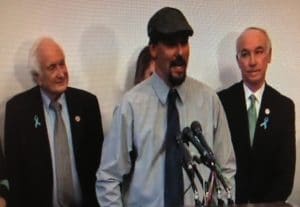
Brother Messier of Albuquerque was a guest of Congresswoman Lujan Grisham’s to President Obama’s State of the Union Address.
“The House of Representatives has taken 25 roll call votes since emergency unemployment insurance expired on December 28 of last year. Sadly, not a single one of those votes has been to restore this vital economic lifeline to the nearly 7,500 New Mexico jobseekers who have been left out in the cold,” Rep. Lujan Grisham said. “Every day that Congress fails to renew unemployment insurance, it harms more and more Americans just like my guest, Coby Messier – people who, in addition to fighting to find a job, now have to fight just to keep a roof over their head, feed their family and pay their bills. It’s long past time for Congress to stop putting New Mexico families in peril and do what’s right for our constituents, our communities and our economy.”
“I am honored that Congresswoman Lujan Grisham has invited me to attend the State of the Union Address on behalf of the nearly 7,500 New Mexico jobseekers who have lost their emergency unemployment insurance,” Mr. Messier said. “I want to thank Congresswoman Lujan Grisham for continuing to call for action on this important issue and for her tireless commitment to helping New Mexico families.”
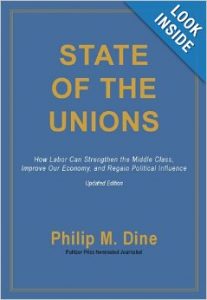
Dine takes a look at what happened to organized labor in America and what can be done to restore it to its role of the defender of middle-class values and economic well-being.
Dine offers firsthand accounts of the union members striving to make their voices heard in a political landscape increasingly shaped by corporate interests, including how:
- The women of Delta Pride-a major player in the multi-billion dollar catfish industry-went up against generations of racial and economic prejudice
- Iowa’s firefighters union flexed its collective muscle to score a major political victory in the 2004 caucus
- The American Federation of Teachers and the AFL-CIO played a key role in bringing down the Iron Curtain
- The Teamsters enlisted community support to temporarily stop a move by Mr. Coffee to relocate to Mexico and saved nearly 400 manufacturing jobs in the Cleveland area
A reporter who has covered labor for two decades, Dine not only details where labor has gone wrong, but he also offers ideas on how it can adapt to a global economy to recover the ground it lost over the last quarter century. His book also has been updated to cove the latest assault on workers from Wisconsin to Ohio, to today’s current war in Pennsylvania and everywhere in between.
A link to purchase his book is available here.
The head of New Jersey’s transit agency Feb. 3 defended the response to delays for thousands of fans leaving the Super Bowl by train, as officials sought to understand how ridership estimates could have been so far off base.
About 33,000 people took the 7-mile ride between MetLife Stadium and the Secaucus rail transfer station, more than double the highest estimates made by organizers and transportation experts before the game. The overcrowding on the platform grew so severe immediately following the game that the stadium scoreboard flashed a sign asking fans to remain inside.
The Super Bowl was held Sunday, Feb. 2, at Met-Life Stadium in New Jersey. It was billed as the first outdoor/mass transit Super Bowl.
“I received an email this morning from New Jersey Transit Vice President and General Manager Kevin O’Connor, thanking our UTU/SMART members for a job well done,” said New Jersey General Chairperson Michael J. Reilly. “Our members of Local 60 in Newark, N.J., came out in force, as there were more than 70 extra assignments to be filled on both Saturday and Sunday. Not only did they come out, our crews were exceptional in their duties and professional in very demanding situations.”
In a message to Reilly and Brotherhood of Locomotive Engineers and Trainmen General Chairperson Dave Decker, O’Conner wrote: “Just wanted to express my thanks to both of you, as well as to your members. We filled virtually every job on Saturday and Sunday and on Sunday carried an unprecedented 28,000 people to the Meadowlands and took out over 32,000. I spoke to many employees as I saw them on Saturday and Sunday and thanked them for their efforts, but of course that was only a fraction of the work force, so please pass this on to everyone.
Great job by all and greatly appreciated. Thank you.
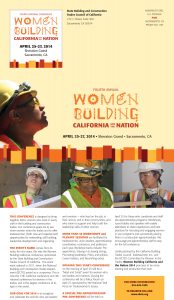
To register on-line click one of the links that follow:
If you are an individual registering one or more participants register here.
If you are an organization registering one or more participants register here.
If you are an individual or organization registering one or more pre-apprentices register here.
If you are only attending the Pre-Apprentice Pre-Conference register here.
If you want to make a contribution click here.
Click here for a copy of the event brochure
You can also email sistersinsmart@gmail.com for further information.
To register for a room on-line at the conference hotel, click the link below.
SHERATON GRAND SACRAMENTO HOTEL
916-447-1700 (Mention “Women Building” Conference)
1230 J Street
Sacramento, CA 95814
CLICK now to reserve your room on line at the Sheraton

Included in this issue:
- – New message from the General President about the SMART Constitution
- – Improvements at the National Pension Fund
- – SMART Living
- – Profile of Local 17 member Paul Lesickza
- – New program for members’ assistance. . .
- and much more.
This past summer the WWSM JATC hosted a five-day training session that provided 15 members and contractor representatives with both the Level 1 Technician and Level 2 Supervisor training required to begin to chase this work. Additionally, the WWSM JATC has begun installation of two complete fire life safety labs that will allow them to demonstrate directly to building officials how fire life safety systems work and how they should be inspected. Modeled after labs used in Local 33, the two Local 66 labs will be located in the Everett and DuPont JATC training centers, making it easier to prepare as many Local 66 members as possible to do this work.
Both SMACNA Western Washington and SMART Sheet Metal Local 66 are encouraged by the level of training participation and the attention members and contractors alike are showing in fire life safety as a viable work opportunity.
 Throughout the past year, we have shared major portions of our history, as documented by labor historian Grace Palladino. She has provided an insightful and candid look at several major issues addressed by your union’s leadership since publication of an earlier history in 1981. Our objective in this current effort was to detail actions taken on strategic decisions made to advance the union’s mission and to benefit its members. What we have received, as a contribution to the 125th anniversary of the founding of the Sheet Metal Workers’ International Association, is an independent examination of our records and personal interviews with a number of officers and staff who were personally involved in many of these issues. I hope you have found it interesting and informative. Current and future leaders, we believe, will benefit from this transparent look at decision making.
Throughout the past year, we have shared major portions of our history, as documented by labor historian Grace Palladino. She has provided an insightful and candid look at several major issues addressed by your union’s leadership since publication of an earlier history in 1981. Our objective in this current effort was to detail actions taken on strategic decisions made to advance the union’s mission and to benefit its members. What we have received, as a contribution to the 125th anniversary of the founding of the Sheet Metal Workers’ International Association, is an independent examination of our records and personal interviews with a number of officers and staff who were personally involved in many of these issues. I hope you have found it interesting and informative. Current and future leaders, we believe, will benefit from this transparent look at decision making.
My reading of our history leads me to a couple of conclusions. SMART has a strong base on which to build its future. Its leadership is as resilient, creative and unstoppable as ever. We owe much to the generations of leaders over the past 33 years—leaders who fought hard to protect our interests and our families’ welfare. If not for forward-thinking leaders like Edward J. Carlough, we would not be where we are today. General President of the Sheet Metal Workers’ International Association between 1970 and 1993—a generally lean period for union construction workers—he fully believed that God helped those who helped themselves. “That’s why we created SASMI, a national training fund, a national pension fund, and NEMI,” he noted. And that’s why Engineering News- Record named him Construction Man of he Year in 1975, a time when the Business Roundtable was pushing open-shop construction, and doublebreasted union/nonunion firms were on the rise. “I’ve never held my breath waiting for someone to help me,” he said, “and I never will.”
Arthur Moore, who took over as IA president in 1993, provided strong financial leadership and made hard decisions to help strengthen the National Pension Fund. “Our goal must be to preserve our pensions,” he told the membership. Michael J. Sullivan became the next General President, placing a high priority on the union’s organizing program to help build membership and increase contributions to the pension fund. He also saw the advantages of mergers, which ultimately led to the decision by the United Transportation Union to join in forming the International Association of Sheet Metal, Air, Rail and Transportation Workers (SMART).
The experiences of these recent General Presidents have greatly influenced me throughout my career. Each had a different approach in leading the union, but they all had the same dedication and understanding that the members come first in all deliberations. It is now my responsibility to enhance the future of this great union by successfully concluding the merger of our union and promoting the value of our members’ expertise, whether in construction, manufacturing, or transportation.
As this year comes to a close, I extend season’s greetings to you, your family, and friends and wish you the very best of happiness, good health, and success in the coming year.
Fraternally yours,
Joseph J. Nigro
